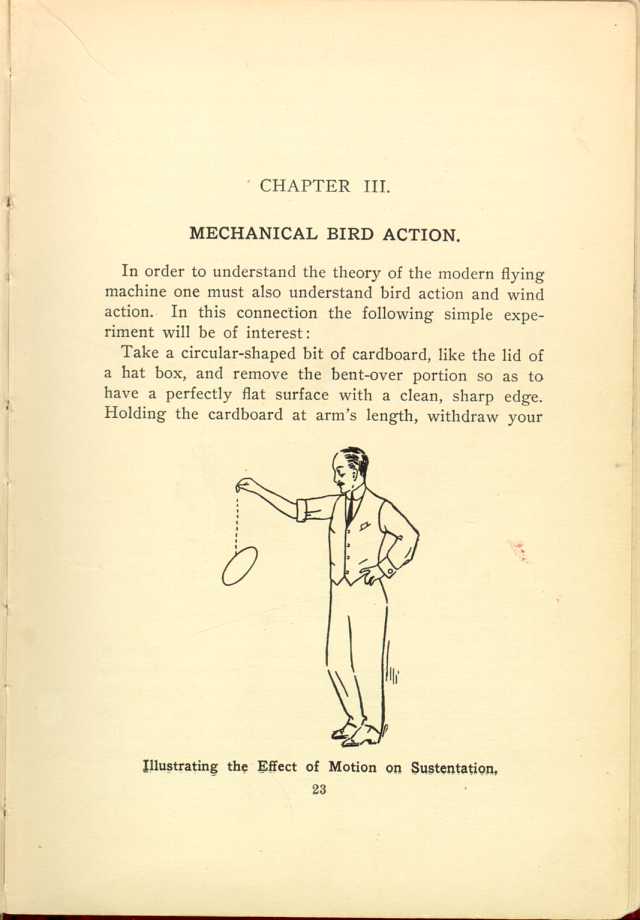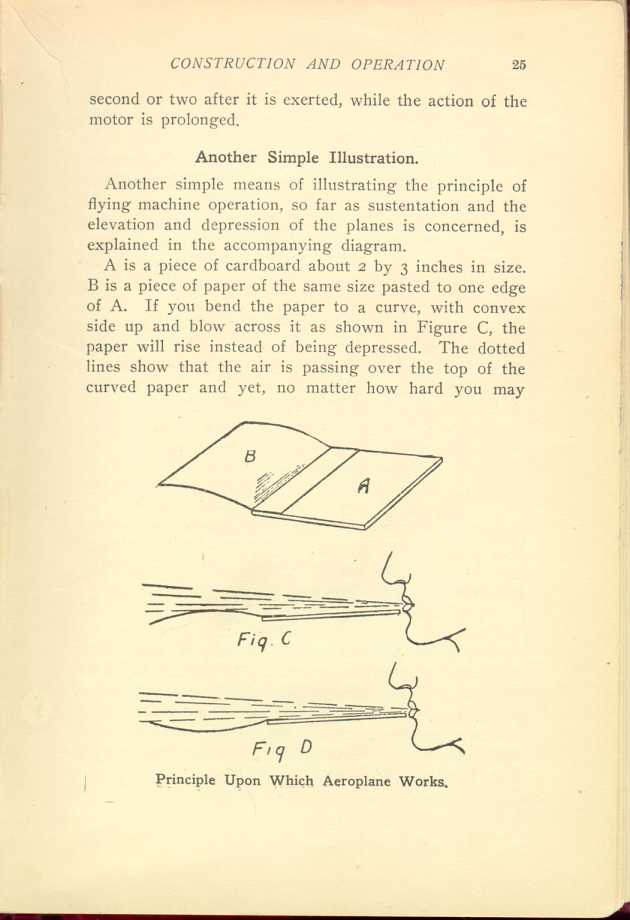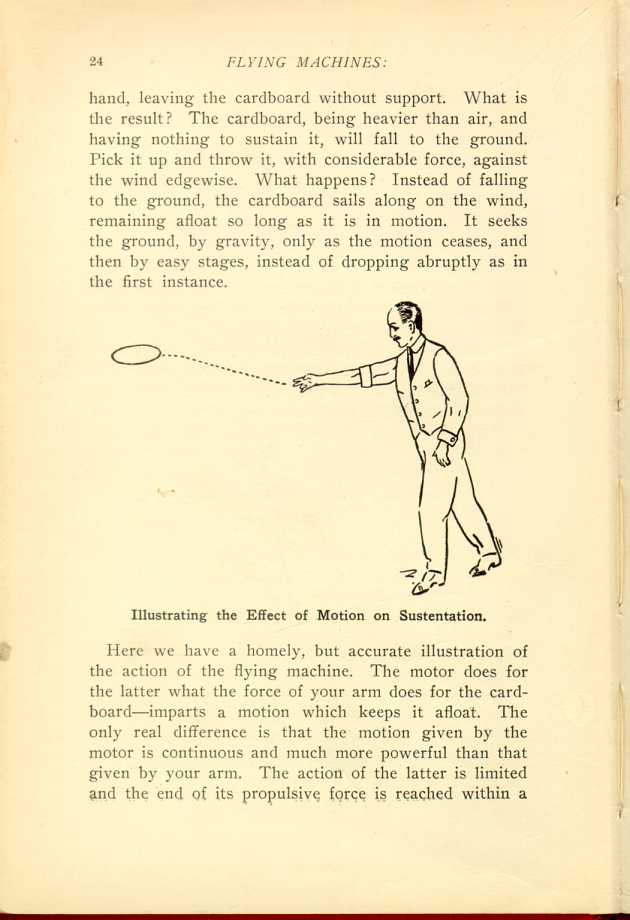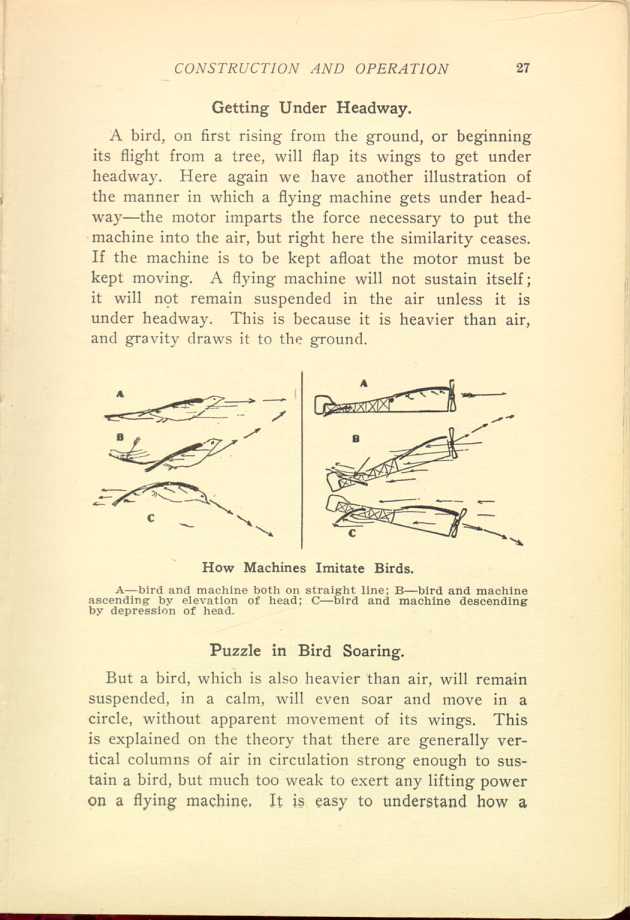| CHAPTER III.
MECHANICAL BIRD ACTION. Flying Machines: Construction and Operation: A Practical Book Which Shows, in Illustrations, Working Plans and Text, How to Build and Navigate the Modern Airship. | ||
3. CHAPTER III.
MECHANICAL BIRD ACTION.
In order to understand the theory of the modern flying machine one must also understand bird action and wind action. In this connection the following simple experiment will be of interest:
Take a circular-shaped bit of cardboard, like the lid of a hat
box, and remove the bent-over portion so as to have a perfectly flat
surface with a clean, sharp edge. Holding the cardboard at arm's
length, withdraw your

Illustrating the Effect of Motion on Sustenation.
[Description: Black and white illustration: Man dropping a disc-like object.]
Here we have a homely, but accurate illustration of the action of the flying machine. The motor does for the latter what the force of your arm does for the card-board—imparts a motion which keeps it afloat. The only real difference is that the motion given by the motor is continuous and much more powerful than that given by your arm. The action of the latter is limited and the end of its propulsive force is reached within a
Another Simple Illustration.
Another simple means of illustrating the principle of flying machine operation, so far as sustentation and the elevation and depression of the planes is concerned, is explained in the accompanying diagram.
A is a piece of cardboard about 2 by 3 inches in size. B is a
piece of paper of the same size pasted to one edge of A. If you bend the
paper to a curve, with convex side up and blow across it as shown in
Figure C, the paper will rise instead of being depressed. The dotted
lines show that the air is passing over the top of the curved paper and
yet, no matter how hard you may

Principle Upon Which Aeroplane Works.
[Description: Black and white illustration: Top: piece of paper attached to
piece of cardboard. Middle: person blowing air onto paper with convex
side up. Bottom: same, but with concave side up.]
In Figure D we have an opposite effect. Here the paper is in a curve exactly the reverse of that shown in Figure C, bringing the concave side up. Now if you will again blow across the surface of the card the action of the paper will be downward—it will be impossible to make it rise. The harder you blow the greater will be the downward movement.
Principle In General Use.
This principle is taken advantage of in the construction of all successful flying machines. Makers of monoplanes and biplanes alike adhere to curved bodies, with the concave surface facing downward. Straight planes were tried for a time, but found greatly lacking in the power of sustentation. By curving the planes, and placing the concave surface downward, a sort of inverted bowl is formed in which the air gathers and exerts a buoyant effect. Just what the ratio of the curve should be is a matter of contention. In some instances one inch to the foot is found to be satisfactory; in others this is doubled, and there are a few cases in which a curve of as much as 3 inches to the foot has been used.
Right here it might be well to explain that the word "plane" applied to flying machines of modern construction is in reality a misnomer. Plane indicates a flat, level surface. As most successful flying machines have curved supporting surfaces it is clearly wrong to speak of "planes," or "aeroplanes." Usage, however, has made the terms convenient and, as they are generally accepted and understood by the public, they are used in like manner in this volume.
Getting Under Headway.
A bird, on first rising from the ground, or beginning its flight from a tree, will flap its wings to get under headway. Here again we have another illustration of the manner in which a flying machine gets under headway—the motor imparts the force necessary to put the machine into the air, but right here the similarity ceases. If the machine is to be kept afloat the motor must be kept moving. A flying machine will not sustain itself; it will not remain suspended in the air unless it is under headway. This is because it is heavier than air, and gravity draws it to the ground.
Puzzle in Bird Soaring.
But a bird, which is also heavier than air, will remain suspended, in a calm, will even soar and move in a circle, without apparent movement of its wings. This is explained on the theory that there are generally vertical columns of air in circulation strong enough to sustain a bird, but much too weak to exert any lifting power on a flying machine, It is easy to understand how a
Modeled Closely After Birds.
So far as possible, builders of flying machines have taken what may be called "the architecture" of birds as a model. This is readily noticeable in the form of construction. When a bird is in motion its wings (except when flapping) are extended in a straight line at right angles to its body. This brings a sharp, thin edge against the air, offering the least possible surface for resistance, while at the same time a broad surface for support is afforded by the flat, under side of the wings. Identically the same thing is done in the construction of the flying machine.
Note, for instance, the marked similarity in form as shown in the illustration in Chapter II. Here A is the bird, and B the general outline of the machine. The thin edge of the plane in the latter is almost a duplicate of that formed by the outstretched wings of the bird, while the rudder plane in the rear serves the same purpose as the bird's tail.
| CHAPTER III.
MECHANICAL BIRD ACTION. Flying Machines: Construction and Operation: A Practical Book Which Shows, in Illustrations, Working Plans and Text, How to Build and Navigate the Modern Airship. | ||

